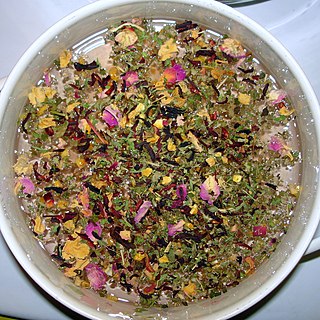
Alkaloids are a class of naturally occurring organic compounds that mostly contain basic nitrogen atoms. This group also includes some related compounds with neutral and even weakly acidic properties. Some synthetic compounds of similar structure may also be termed alkaloids. In addition to carbon, hydrogen and nitrogen, alkaloids may also contain oxygen, sulfur and, more rarely, other elements such as chlorine, bromine, and phosphorus.

Cocaine, also known as coke, is a strong stimulant mostly used as a recreational drug. It is commonly snorted, inhaled as smoke, or dissolved and injected into a vein. Mental effects may include loss of contact with reality, an intense feeling of happiness, or agitation. Physical symptoms may include a fast heart rate, sweating, and large pupils. High doses can result in very high blood pressure or body temperature. Effects begin within seconds to minutes of use and last between five and ninety minutes. Cocaine has a small number of accepted medical uses such as numbing and decreasing bleeding during nasal surgery.

Herbal teas—less commonly called tisanes —are beverages made from the infusion or decoction of herbs, spices, or other plant material in hot water. They do not usually contain caffeine. Herbal teas should not be confused with true teas, which are prepared from the cured leaves of the tea plant, Camellia sinensis, nor with decaffeinated tea, in which the caffeine has been removed. Like beverages made from true teas, herbal teas can be served hot or cold.

Coca is any of the four cultivated plants in the family Erythroxylaceae, native to western South America.

Methylecgonine cinnamate is a natural tropane alkaloid found within the coca plant. Its more common name, cinnamoylcocaine, reflects its close structural similarity to cocaine. It is said to be pharmacologically inactive. But some studies funded by anti-drug agencies imply that it is active when smoked. Furthermore, the discovery of differing impurity products yielding methylecgonine cinnamate in confiscated cocaine have led enforcing agencies to postulate that illicit manufacturers have changed their oxidation procedures when refining cocaine from a crude form. Methylecgonine cinnamate can dimerize to the truxillic acid derivative truxilline. It is notable that methylecgonine cinnamate is given in patents of active cocaine analogue structures.
On a New Organic Base in the Coca Leaves is an 1860 dissertation written by Dr. Albert Niemann. Its title in German is Über eine neue organische Base in den Cocablättern. The piece describes, in detail, how Niemann isolated cocaine, a crystalline alkaloid. It also earned Niemann his Ph.D. and is now in the British Library. He wrote of the alkaloid's "colourless transparent prisms" and said that, "Its solutions have an alkaline reaction, a bitter taste, promote the flow of saliva and leave a peculiar numbness, followed by a sense of cold when applied to the tongue." Niemann named the alkaloid "cocaine" — as with other alkaloids its name carried the "-ine" suffix.

Cuscohygrine is a pyrrolidine alkaloid found in coca. It can also be extracted from plants of the family Solanaceae, including Atropa belladonna, Datura innoxia and Datura stramonium. Cuscohygrine usually occurs along with other, more potent alkaloids such as atropine or cocaine.

Hygrine is a pyrrolidine alkaloid, found mainly in coca leaves (0.2%). It was first isolated by Carl Liebermann in 1889 as an alkaloid accompanying cocaine in coca. Hygrine is extracted as a thick yellow oil, having a pungent taste and odor.

Ecgonine is a tropane alkaloid found naturally in coca leaves. It has a close structural relation to cocaine: it is both a metabolite and a precursor, and as such, it is a controlled substance in many jurisdictions, as are some substances which can be used as precursors to ecgonine itself.

Coca tea, also called mate de coca, is an herbal tea (infusion) made using the raw or dried leaves of the coca plant, which is native to South America. It is made either by submerging the coca leaf or dipping a tea bag in hot water. The tea is most commonly consumed in the Andes mountain range, particularly Argentina, Bolivia, Colombia and especially in Peru, where it is consumed all around the country. It is greenish yellow in color and has a mild bitter flavor similar to green tea with a more organic sweetness.
Friedrich Georg Carl (Friedrich) Gaedcke was a German chemist. He was the first person to isolate the cocaine alkaloid which happened in 1855.
Free base is the conjugate base (deprotonated) form of an amine, as opposed to its conjugate acid (protonated) form. The amine is often an alkaloid, such as nicotine, cocaine, morphine, and ephedrine, or derivatives thereof.
Albert Friedrich Emil Niemann was a German chemist. In 1859 - about the same time as Paolo Mantegazza - he isolated cocaine, and he published his finding in 1860.

Tropacocaine is a cocaine-related alkaloid.
Coca alkaloids are the alkaloids found in the coca plant, Erythroxylum coca. They are predominantly of either the pyrrolidine or the tropane types.

Dihydrocuscohygrine is an alkaloid that has been isolated from coca leaves.

Pseudotropine is a derivative of tropane and an isomer of tropine. Pseudotropine can be found in the Coca plant along with several other alkaloids














